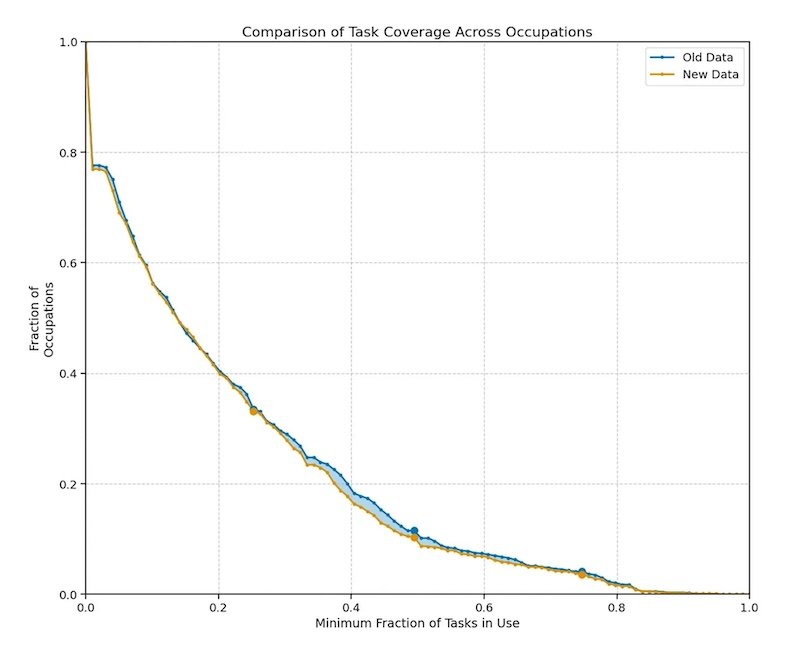Two Years Behind, Five Years Ahead
By: Travis Fleisher
While headlines about AI dominance flood our feeds, Anthropic's recent Economic Index—my favorite source for high-level AI market insights—reveals a compelling truth: we're still in the early phases of AI adoption across most industries. Despite the technology's ubiquity in the broader public consciousness, there remains a significant opportunity window for professionals and businesses that strategically adopt AI tools now.
Understanding the Current State of AI Adoption
Anthropic's recent report presents fascinating data on AI's penetration across occupational categories. The chart below perfectly illustrates how much long-term opportunity still exists, revealing that approximately 40% of occupations currently use AI for only about 20% of their tasks. The near-identical curves between the first and second reports suggest we're witnessing steady but measured integration rather than explosive disruption.
I often describe the current state of AI adoption with a personal philosophy: "two years behind, but five years ahead." By this I mean that professionals who start adopting AI today, while two years behind the initial wave of early adopters, still remain five years ahead of the broader population. This positioning in the adoption curve creates the perfect opportunity window for those entering the space now.
Where AI Is Making the Most Impact
This second chart similarly provides crucial insights into which sectors are experiencing the most significant shifts in AI utilization. Computer and Mathematical occupations predictably lead with the highest absolute increase (+3.8%), but several other categories show notable growth:
Educational Instruction and Library (+3.3%)
Life, Physical, and Social Sciences (+1.0%)
Arts, Design, Entertainment, Sports, and Media (-2.7%, showing a decrease but still maintaining significant overall usage)
This diverse pattern of adoption suggests AI's influence is expanding beyond technical fields into areas previously considered less susceptible to technological augmentation.
Augmentation vs. Automation: The Two Faces of AI Adoption
Before diving deeper into the opportunity window, it's crucial to understand the two fundamental approaches to AI integration:
Augmentation: Enhancing human capabilities by providing tools that improve decision-making, creativity, and efficiency while keeping humans central to the process
Automation: Replacing human tasks entirely with AI systems that can perform them independently
The data from Anthropic's charts suggests most current adoption falls heavily on the augmentation side—AI is being used to enhance existing workflows rather than replace them entirely. This pattern of adoption explains why we're seeing widespread but relatively shallow integration across occupations.
Why This Is Your Window of Opportunity
These charts tell a compelling story about AI adoption: it's widespread but shallow. Most occupations are experimenting with AI for augmentation in a small subset of tasks rather than completely reimagining their workflows through automation. This creates three key opportunities:
First-Mover Advantage: In sectors showing early adoption, professionals who master AI integration now can establish themselves as leaders before standards solidify.
Process Optimization: The relatively low task coverage (20% for many occupations) indicates significant room for expanding AI's application to additional workflows.
Expertise Development: The gradual adoption curve provides time to develop genuine expertise rather than merely basic familiarity.
How to Capitalize on the Adoption Window
Based on Anthropic's data, here are strategic recommendations for professionals looking to stay ahead:
Balance Augmentation and Automation: Strategically assess which tasks would benefit most from augmentation (enhancing human capabilities) versus automation (replacing human tasks entirely).
Identify Low-Hanging Fruit: Focus first on applying AI to routine tasks within your workflow that fall within that crucial 20% where adoption is already beginning.
Cross-Pollinate Ideas: Look to leading sectors like Computer/Mathematical and Education for implementation ideas that could transfer to your field.
Develop Complementary Skills: The data suggests successful AI integration requires human expertise to guide and refine AI outputs, not just technical knowledge.
Monitor Adoption Trends: Regular evaluation of how AI is being used in your field will help identify emerging applications before they become standard.
Conclusion: Early, Not Late
The most important insight from this report isn't how much AI has already transformed work—it's how much transformation still lies ahead. The remarkably consistent adoption curves between reports suggest we're in a steady adoption phase rather than the late stages of a revolution.
My "two years behind, but five years ahead" philosophy perfectly captures this moment: professionals who begin their AI journey today may have missed the very first wave, but they're still well ahead of mainstream adoption. For professionals and organizations willing to invest in AI literacy now, these charts don't represent missed opportunities but rather a clear signal that the window for establishing competitive advantage remains wide open. Those who recognize this reality and act decisively will find themselves not just keeping pace with AI's evolution but helping to define how it reshapes their industries in the years to come.
Travis


